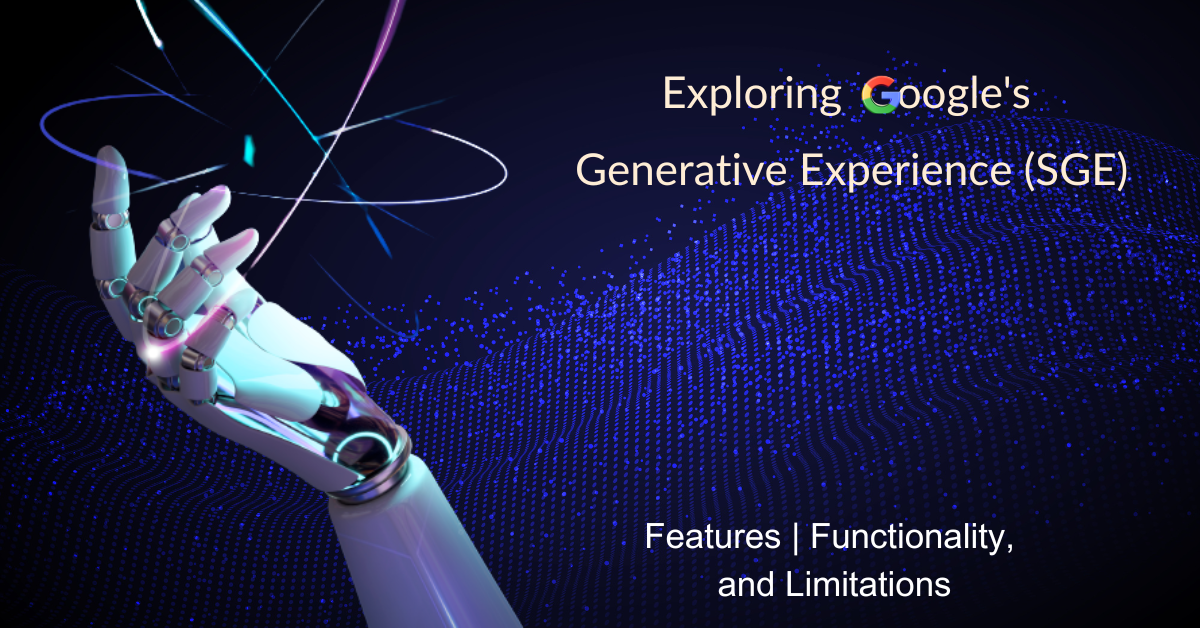
Generative AI: Exploring Google's Search Generative Experience (SGE): Features, Functionality, and Limitations
On May 10, 2023, Google announced the Search Generative Experience (SGE) at its Google I/O conference in Mountain View, California. This came amidst other announcements, including its Android 14 and Pixel Fold.
The SGE offers users a search experience with generative AI to connect people to the richness and vibrancy of content on Google with a focus on high-quality results.
According to a document released by Google, when using SGE, you will notice that your search results page has familiar web results organized in a new way to help you get more from a single search.
This, of course, could be seen as one of Google’s measures to remedy the impact of ChatGPT 4 and other generative AI, which offer searchers a seemingly vast amount of organized information in one result, a situation that is detrimental to Google’s search existence.
Currently, SGE is only available in English and for US-based users. At launch, the Search Labs SGE will also be available only for mobile users of the Google App on both Android and IOS.
Below, we’ll breeze through the features of SGE, how it works, and possible limitations.
What are the Features of Google's Search Generative Experience (SGE)?
According to Google, SGE, which it said is still an early step in transforming the search experience, can do the following:
- Enable users to ask new questions they never thought ai chat could answer.
- Quickly curate information on a topic, with links to relevant results to explore further.
- Enable users to ask follow-up questions naturally in a new conversational style.
- It helps users generate creative ideas and drafts right in the search and get more done.
How Does SGE Work as a Generative AI?
The SGE is an interactive featured snippet requiring user action to trigger the AI Snapshot. The Search Engine Result Page (SERP) is presented so that you can skip past this feature if you want.
Once clicked, it takes about 5 seconds to generate a result. This also means many users might scroll past without waiting for 5 seconds.
The SGE provides an overview of each search, offers searchers conversational modes, and provides vertical experiences. Below are brief explanations of each of these main features.
-
Provides AI Powered Snapshot
SGE may offer users a snapshot of search results containing an overview and links to resources that corroborate the information on the snapshot.
This helps users to dig deeper and explore a diverse range of content from different sources. The pages cited in the AI Snapshot can also appear in the organic results. Each result can be cited more than once.
-
Offers Conversational Mode
SGE also offers an “ask a follow-up,” and other suggested next-step features under the snapshot. This instantly takes you to conversational mode, where you explore the topic further.
According to Google, the conversational mode is “especially useful for follow-up questions, as well as more complex or evolving information.”
-
Offers Vertical Experiences
SGE also offers information relating to shopping or local searches. For example, it can offer shopping insights, a product overview snapshot, and a range of product options. Vertical experiences also include product images, prices, ratings, and up-to-date reviews.
How Responsible is Google’s SGE?
With Open AI’s ChatGPT being accused of occasionally spitting inaccuracies, Google is banking on its core ranking systems to stand out. So, the SGE is trained to acknowledge high-quality and reliable information.
In addition, contents that are explicit, hateful, violent, or against public interest are automatically prevented from showing on the SGE. Interestingly, the SGE is not designed to respond in the first person.
According to Google, this will curtail it from generating responses reflecting opinions and emotions.
What are the Known Limitations of the SGE?
Below, we will list the various limitations the Google team said it observed and potential limitations the SGE may have.
However, it is essential to state that Google indicated in its report that it had taken corrective measures and looks forward to fine-tuning as the SGE progresses.
- There were instances where the Google team observed that the SGE appropriately identified information to corroborate its snapshot, but with slight misinterpretations of language that changed the meaning of the output.
- The SGE may sometimes misrepresent facts or inaccurately identify insights.
- The SGE may also provide biased results since it is trained to respond with high-quality resources, thereby reflecting a narrower range of perspectives than what is available on the web.
- The model may give the impression of displaying persona in some instances where it provides outputs that reflect opinions that exist on the web.
- The SGE may also provide duplicates or contradictions with existing search features. For example, you may see a featured snippet result that highlights the perspective of a single source; however, the SGE represents a combined perspective corroborated in a range of results.
Conclusion
Google’s Search Generative Experience (SGE) uses generative AI to transform the search experience. It allows users to ask new questions, conduct conversational follow-ups, and curate ideas within the search interface.
Google has taken the time to address some concerns around generative AI, including prioritizing high-quality and reliable information.
However, there are acknowledged limitations regarding potential misrepresentation, biased results, personated opinions, and language interpretations.
Despite these challenges, the SGE is still in its early stage, and Google is keen on refining it to provide users with a valuable and responsible search experience.
So, what's your opinion about Google's SGE? Do you think it's the missing piece the tech giant needs to stay ahead of the game in Generative AI?
There are no comments for now. Be the first comment